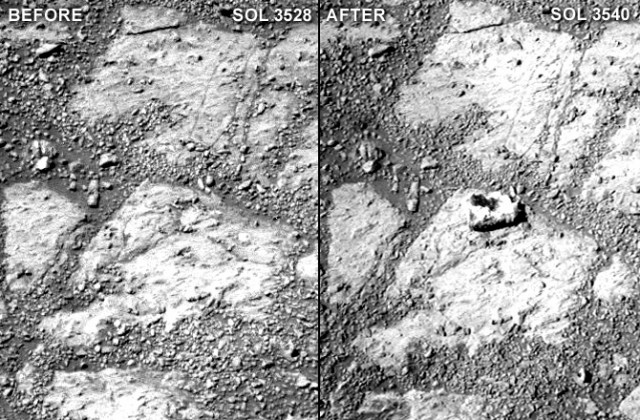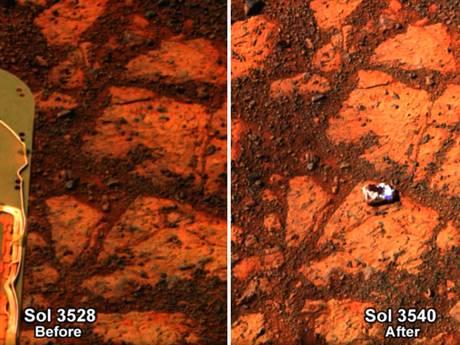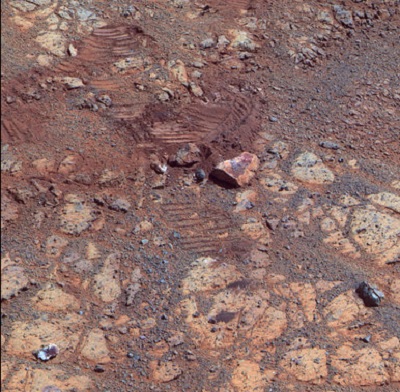.
20.01.2014

Donut-sized rock suddenly appears in front of Mars rover
Where did that come from?
Nasa says Mars mystery rock that ‘appeared’ from nowhere is ‘like nothing we’ve seen before’
A mysterious rock which appeared in front of the Opportunity rover is “like nothing we’ve ever seen before”, according to Mars exploration scientists at Nasa.


The mystery of the jelly doughnut-shaped rock that seemed to materialize on Mars is a mystery no more.
After taking a close look at the small white rock with a deep red center dubbed "Pinnacle Island," a research team has determined it is not a fungus-like organism, or a piece of Martian ejecta that was shot into the air by a nearby unseen impact.
Instead, it is just a small piece that was broken off a larger rock when one of the wheels of NASA's Opportunity rover drove over it, according to a release from the Jet Propulsion Laboratory.
"Once we moved Opportunity a short distance, after inspecting Pinnacle Island, we could see directly uphill an overturned rock that has the same unusual appearance," said Opportunity Deputy Principal Investigator Ray Arvidson in a statement. "We drove over it. We can see the track. That's where Pinnacle Island came from."
The small rock became a subject of worldwide interest soon after it was spotted Jan. 8 by Opportunity's cameras. It was puzzling because it did not show up in images the rover took of the same location taken 12 days earlier.
"One of the things I like to say is Mars keeps throwing things at us," Steven Squyres, principal investigator for the Mars Exploration Rover Mission, said during a presentation describing the appearance of the mysterious rock in January.
"We're completely confused. We're having a wonderful time. Everyone on the team is arguing and fighting," he said at the time.
The story took a strange turn at the end of January when Rhawn Joseph, who describes himself as a neuroscientist and astrobiologist, filed court papers demanding that NASA do more to investigate the mysterious rock.
Joseph asked the judge to order the space agency to closely photograph the rock from several angles, thoroughly examine it, and share that information with the public.
In the court papers Joseph suggests that the rock may not be a rock at all, but rather a fungus-like organism. If so, that would mean Opportunity had discovered life on Mars.
A NASA spokesman responded with this: "As we do with all our scientific research missions, NASA will continue to discuss any new data regarding the rock and other images and information as new data becomes available."
Even if the rock is not a sign of extraterrestrial life, it is still interesting. Opportunity's instruments have revealed that it has high levels of sulfur and manganese, water soluble ingredients that may have been concentrated in the rock thanks to the action of water.
"This may have happened just beneath the surface relatively recently, or it may have happened deeper below the ground long ago," Arvidson said in a statement. "And then by serendipity, erosion stripped away material above it and made it accessible to our wheels."
A mystery? Not anymore. But it appears it was still a stroke of luck.
Quelle: Los Angeles Times
.
Mars Rover Heads Uphill After Solving 'Doughnut' Riddle
Researchers have determined the now-infamous Martian rock resembling a jelly doughnut, dubbed Pinnacle Island, is a piece of a larger rock broken and moved by the wheel of NASA's Mars Exploration Rover Opportunity in early January.
Only about 1.5 inches wide (4 centimeters), the white-rimmed, red-centered rock caused a stir last month when it appeared in an image the rover took Jan. 8 at a location where it was not present four days earlier.
More recent images show the original piece of rock struck by the rover's wheel, slightly uphill from where Pinnacle Island came to rest.
"Once we moved Opportunity a short distance, after inspecting Pinnacle Island, we could see directly uphill an overturned rock that has the same unusual appearance," said Opportunity Deputy Principal Investigator Ray Arvidson of Washington University in St. Louis. "We drove over it. We can see the track. That's where Pinnacle Island came from."
Examination of Pinnacle Island revealed high levels of elements such as manganese and sulfur, suggesting these water-soluble ingredients were concentrated in the rock by the action of water. "This may have happened just beneath the surface relatively recently," Arvidson said, "or it may have happened deeper below ground longer ago and then, by serendipity, erosion stripped away material above it and made it accessible to our wheels."
Now that the rover is finished inspecting this rock, the team plans to drive Opportunity south and uphill to investigate exposed rock layers on the slope.
Opportunity is approaching a boulder-studded ridge informally named the McClure-Beverlin Escarpment, in honor of engineers Jack Beverlin and Bill McClure. Beverlin and McClure were the first recipients of the NASA Medal of Exceptional Bravery for their actions on Feb. 14, 1969 to save NASA's second successful Mars mission, Mariner 6, when the launch vehicle began to crumple on the launch pad from loss of pressure.
"Our team working on Opportunity's continuing mission of exploration and discovery realizes how indebted we are to the work of people who made the early missions to Mars possible, and in particular to the heroics of Bill McClure and Jack Beverlin," said rover team member James Rice of the Planetary Science Institute, Tucson, Ariz. "We felt this was really a fitting tribute to these brave men, especially with the 45th anniversary of their actions coming today."
Opportunity's work on the north-facing slope below the escarpment will give the vehicle an energy advantage by tilting its solar panels toward the winter sun. Feb. 14 is the winter solstice in Mars' southern hemisphere, where Opportunity has been working since it landed in January 2004.
"We are now past the minimum solar-energy point of this Martian winter," said Opportunity Project Manager John Callas of NASA's Jet Propulsion Laboratory (JPL) in Pasadena, Calif. "We now can expect to have more energy available each week. What's more, recent winds removed some dust from the rover's solar array. So we have higher performance from the array than the previous two winters."
During Opportunity's decade on Mars, and the 2004-2010 career of its twin, Spirit, NASA's Mars Exploration Rover Project has yielded a range of findings proving wet environmental conditions on ancient Mars -- some very acidic, others milder and more conducive to supporting life.
Quelle: NASA
